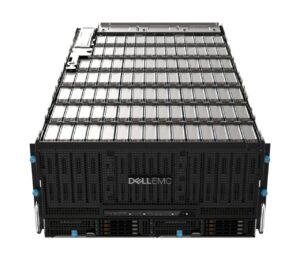Nothing seems to grow faster than the need for storage. With IoT, image, and video objects feeding “big data” analytics systems, that growth curve can be steep as new systems are placed online. Dell Technologies has engineered its latest storage server with a focus on high-density, high-capacity storage customers.
Recently, Dell Technologies commissioned Tolly to study the specifications and characteristics of its Dell EMC PowerEdge XE7100 and provide analysis and context as to where the device sits in terms of advancing the industry.
Tolly found that the Dell EMC PowerEdge XE7100 Storage Server provides significant scalability and efficiency benefits both compared to prior generation systems and compared to current generation systems of a leading competitor. Significantly, the unit provides module server sled options that allow for high-performance optimization for specific application focus areas such storage/archival, intelligent video analysis (IVA), and media streaming.
Our analysis contrasted the Dell EMC PowerEdge with the specifications of a leading competitor. As you shall see, the Dell EMC PowerEdge XE7100 showed significant scalability benefits as well as significant efficiency advantages. As we say in the report, “More is more… and less is more” – the benefits are manifold.
Scalability
 Let’s start with scalability. The Dell EMC XE7100 supports 100 disks in total. It is top-loading with rows of mostly 15 disks per row. That capacity is 67% greater than a leading competitor. Filling a 42U rack with eight of the 5U Dell EMC PowerEdge XE7100 units gives you 800 disk drives in a single, STANDARD-size rack. Some storage providers require racks with unusual dimensions. Such racks can cause complexity in the data center and reduce physical space available between rows of racks.
Let’s start with scalability. The Dell EMC XE7100 supports 100 disks in total. It is top-loading with rows of mostly 15 disks per row. That capacity is 67% greater than a leading competitor. Filling a 42U rack with eight of the 5U Dell EMC PowerEdge XE7100 units gives you 800 disk drives in a single, STANDARD-size rack. Some storage providers require racks with unusual dimensions. Such racks can cause complexity in the data center and reduce physical space available between rows of racks.
So, it is important to note that using a standard-size rack, the number of drives supported per rack with the Dell EMC PowerEdge XE7100 is 33% greater than a leading competitor. The units now support 18TB drives and this provides for a massive 14.4 Petabytes of storage in a single rack.
Efficiency
Now on to efficiency… Where many storage servers are 4U, the fact that the Dell EMC PowerEdge XE7100 is 5U provides additional efficiency at the rack level. That is, eight units of the Dell EMC PowerEdge XE7100 fill a 42U rack where it would require 10 units of a 4U storage server to fill the rack.
And the efficiency of the Dell EMC XE7100 extends to its power and cabling requirements as well. Dell Technologies has optimized power supplies and the cabling that goes along with power. And, because fewer units are required to fill a rack, that benefits of that optimization extend beyond the unit to the rack overall.
Where a leading competitor requires four 1600W power supplies per unit, the Dell EMC PowerEdge XE7100 requires only two 2400W power supplies which reduces cabling complexity, allows the user to optimize expensive infrastructure items like power distribution units (PDUs) and reduces energy consumption.
At the unit level, that is a 50% reduction in power supplies required that, at a rack level, is a 60% reduction in power cables. Dell EMC provisions 25% less power per unit and 40% lower total power per rack. Reducing cabling needs reduces overall complexity of data center and rack management.
Data centers are “forever” – and, thus, optimizing operational costs can cast a long shadow and provide “forever” benefits. There is an increasing focus on “sustainable” data centers. Power consumption and energy efficiency are at the core of providing that kind of sustainability. Reductions of 25% power per unit and 40% per rack can provide far reaching benefits with respect to better power efficiency and these benefits only increase as more existing units are replaced by the Dell EMC PowerEdge XE7100.
Flexibility
Not all storage deployments are identical. The type of data and the activities planned can warrant different processing options. The Dell EMC solution offers two different server sled options each of which can be further customized for a particular storage application. The PowerEdgeXE7100, powered by 2nd generation Intel® Xeon® Scalable processors, can be deployed with a single XE7440 full-width sled or up to two XE7420 half-width sleds with various options available for each.
Conclusion
The Dell EMC PowerEdge provides high-density disk capacity with fewer units required per rack. The Dell EMC approach provides fewer power cables per unit and per rack along with lower power provisioning at both levels. Read the full report, available at both the Dell and Tolly report sites.
